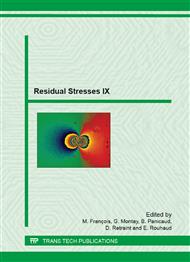p.82
p.88
p.94
p.100
p.106
p.112
p.118
p.124
p.128
Modeling Methodology for Stress Determination by XRD in Polycrystalline Materials
Abstract:
To get a quantitative estimate of residual stresses in polycrystals from XRD measurements, a micromechanical modeling is required, except in particular cases. The most widely used method is only valid for homogeneous and isotropic samples. We present here the possibility to determine residual stresses by coupling measurements with the portable INELTM Xsolo equipement with a self-consistent polycrystalline model. This methodology may take into account texture and intergranular stresses induced by thermomechanical treatments. One example obtained for titanium subjected to tensile loading illustrates the methodology.
Info:
Periodical:
Pages:
106-111
Citation:
Online since:
August 2014
Keywords:
Permissions:
Share:
Citation:


